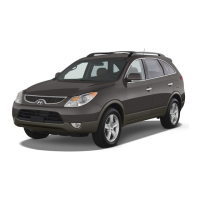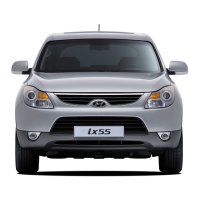Do you have a question about the Hyundai VENUE and is the answer not in the manual?
Indicates a hazardous situation that will result in death or serious injury if not avoided.
Indicates a hazardous situation that could result in death or serious injury if not avoided.
Indicates a hazardous situation that could result in minor or moderate injury if not avoided.
Indicates a situation that could result in vehicle damage if not avoided.
Explains the manual's structure of chapters, sections, and index for easy navigation.
Specifies the required unleaded fuel octane rating and benefits of using it.
Provides information on using leaded fuel, if applicable to the vehicle.
Warns against using gasohol with more than 10% ethanol or any methanol.
Lists other fuels that may cause damage or issues and recommends avoiding them.
Provides a diagram and list of exterior components visible from the front view.
Details exterior components visible from the rear view, including lamps and tailgate.
Shows and labels the components and indicators on the instrument panel.
Identifies key components and reservoirs located in the engine bay for both petrol and diesel engines.
Explains the adjustment and features of front and rear seats, including headrests.
Details the proper use, adjustment, and care of seat belts for maximum protection.
Covers the importance and proper installation of child restraint systems, emphasizing rear seat use.
Explains the SRS components, operation, and precautions for air bag safety.
Describes how to use the remote key and smart key for locking, unlocking, and tailgate access.
Explains operating door locks using the mechanical key and remote key, including interior controls.
Covers opening, closing, and emergency release procedures for the tailgate.
Details the operation of power and manual windows, including auto up/down and child lock features.
Provides instructions for opening and closing the hood, including safety precautions for the support rod.
Explains how to slide, tilt, and reset the sunroof, along with operating precautions.
Covers electric power steering operation, adjustments, and horn usage.
Identifies and explains the function of various gauges, indicators, and displays on the instrument cluster.
Lists and explains the meaning of various warning and indicator lights on the instrument panel.
Guides on using USB ports for media devices and compatibility.
Explains how to use audio controls on the steering wheel for radio and media.
Covers connecting and using Bluetooth devices for hands-free calls and audio.
Explains how to make, receive, and manage calls using the Bluetooth system.
Familiarizes users with status icons displayed on the screen for current system status.
Lists supported audio formats and USB storage device specifications for the system.
Lists essential checks and precautions before starting the vehicle, including safety warnings.
Explains the different ignition switch positions and safety precautions.
Provides step-by-step instructions for starting petrol, diesel, and iMT engines.
Details the operation of the manual transmission, including shifting and precautions.
Explains the operation of the dual clutch transmission, including its features and driving feel.
Covers power brakes, disc brake wear indicators, rear drum brakes, and parking brake operation.
Explains how ABS works, its benefits, limitations, and warning lights.
Describes the ESC system's function in stabilizing the vehicle and how to operate it.
Guides on operating cruise control, setting speed, and conditions for cancellation.
Offers advice for driving in hazardous conditions like water, snow, ice, mud, or sand.
Provides precautions for driving in snow or icy conditions, including tire and chain usage.
Explains the function and operation of hazard warning flashers for emergencies.
Provides troubleshooting steps for when the engine fails to start or cranks slowly.
Details the procedure and safety precautions for jump starting a vehicle with a dead battery.
Guides on actions to take if the engine overheats, including safety warnings about hot components.
Explains the TPMS indicators, proper tire pressure checks, and malfunction warnings.
Covers the process of changing a tire, including safety precautions and tool usage.
Provides recommendations for emergency towing services and procedures for towing without dollies.
Lists checks to perform when stopping for fuel and while operating the vehicle.
Differentiates between normal and severe usage schedules for vehicle maintenance.
Provides a detailed schedule for regular maintenance of petrol engines.
Outlines the regular maintenance schedule for diesel engines based on intervals.
Explains the procedures for maintaining items like engine oil, drive belts, and fuel filters.
Guides on checking and changing engine oil levels for both petrol and diesel engines.
Covers checking coolant levels and changing coolant, including safety warnings.
Explains fuse types, replacement procedures, and warnings about incorrect replacements.
Warns about safety precautions before replacing lights and provides instructions for various bulbs.
Lists the vehicle's overall dimensions, including width, height, and wheelbase.
Provides specifications for petrol and diesel engines, including displacement, bore, stroke, and cylinders.
Details the bulb types and wattages for various exterior and interior lights.
Covers tire sizes, inflation pressures, and wheel torque specifications.
Lists recommended lubricants and fluids for engine, transmission, and coolant.
Explains how engine oil viscosity affects performance and provides a temperature chart for selection.
Explains where to find the VIN and its importance for registration and legal matters.
Indicates where to find tire pressure recommendations on the driver's side center pillar.
Indicates a hazardous situation that will result in death or serious injury if not avoided.
Indicates a hazardous situation that could result in death or serious injury if not avoided.
Indicates a hazardous situation that could result in minor or moderate injury if not avoided.
Indicates a situation that could result in vehicle damage if not avoided.
Explains the manual's structure of chapters, sections, and index for easy navigation.
Specifies the required unleaded fuel octane rating and benefits of using it.
Provides information on using leaded fuel, if applicable to the vehicle.
Warns against using gasohol with more than 10% ethanol or any methanol.
Lists other fuels that may cause damage or issues and recommends avoiding them.
Provides a diagram and list of exterior components visible from the front view.
Details exterior components visible from the rear view, including lamps and tailgate.
Shows and labels the components and indicators on the instrument panel.
Identifies key components and reservoirs located in the engine bay for both petrol and diesel engines.
Explains the adjustment and features of front and rear seats, including headrests.
Details the proper use, adjustment, and care of seat belts for maximum protection.
Covers the importance and proper installation of child restraint systems, emphasizing rear seat use.
Explains the SRS components, operation, and precautions for air bag safety.
Describes how to use the remote key and smart key for locking, unlocking, and tailgate access.
Explains operating door locks using the mechanical key and remote key, including interior controls.
Covers opening, closing, and emergency release procedures for the tailgate.
Details the operation of power and manual windows, including auto up/down and child lock features.
Provides instructions for opening and closing the hood, including safety precautions for the support rod.
Explains how to slide, tilt, and reset the sunroof, along with operating precautions.
Covers electric power steering operation, adjustments, and horn usage.
Identifies and explains the function of various gauges, indicators, and displays on the instrument cluster.
Lists and explains the meaning of various warning and indicator lights on the instrument panel.
Guides on using USB ports for media devices and compatibility.
Explains how to use audio controls on the steering wheel for radio and media.
Covers connecting and using Bluetooth devices for hands-free calls and audio.
Explains how to make, receive, and manage calls using the Bluetooth system.
Familiarizes users with status icons displayed on the screen for current system status.
Lists supported audio formats and USB storage device specifications for the system.
Lists essential checks and precautions before starting the vehicle, including safety warnings.
Explains the different ignition switch positions and safety precautions.
Provides step-by-step instructions for starting petrol, diesel, and iMT engines.
Details the operation of the manual transmission, including shifting and precautions.
Explains the operation of the dual clutch transmission, including its features and driving feel.
Covers power brakes, disc brake wear indicators, rear drum brakes, and parking brake operation.
Explains how ABS works, its benefits, limitations, and warning lights.
Describes the ESC system's function in stabilizing the vehicle and how to operate it.
Guides on operating cruise control, setting speed, and conditions for cancellation.
Offers advice for driving in hazardous conditions like water, snow, ice, mud, or sand.
Provides precautions for driving in snow or icy conditions, including tire and chain usage.
Explains the function and operation of hazard warning flashers for emergencies.
Provides troubleshooting steps for when the engine fails to start or cranks slowly.
Details the procedure and safety precautions for jump starting a vehicle with a dead battery.
Guides on actions to take if the engine overheats, including safety warnings about hot components.
Explains the TPMS indicators, proper tire pressure checks, and malfunction warnings.
Covers the process of changing a tire, including safety precautions and tool usage.
Provides recommendations for emergency towing services and procedures for towing without dollies.
Lists checks to perform when stopping for fuel and while operating the vehicle.
Differentiates between normal and severe usage schedules for vehicle maintenance.
Provides a detailed schedule for regular maintenance of petrol engines.
Outlines the regular maintenance schedule for diesel engines based on intervals.
Explains the procedures for maintaining items like engine oil, drive belts, and fuel filters.
Guides on checking and changing engine oil levels for both petrol and diesel engines.
Covers checking coolant levels and changing coolant, including safety warnings.
Explains fuse types, replacement procedures, and warnings about incorrect replacements.
Warns about safety precautions before replacing lights and provides instructions for various bulbs.
Lists the vehicle's overall dimensions, including width, height, and wheelbase.
Provides specifications for petrol and diesel engines, including displacement, bore, stroke, and cylinders.
Details the bulb types and wattages for various exterior and interior lights.
Covers tire sizes, inflation pressures, and wheel torque specifications.
Lists recommended lubricants and fluids for engine, transmission, and coolant.
Explains how engine oil viscosity affects performance and provides a temperature chart for selection.
Explains where to find the VIN and its importance for registration and legal matters.
Indicates where to find tire pressure recommendations on the driver's side center pillar.
| Brand | Hyundai |
|---|---|
| Model | VENUE |
| Category | Automobile |
| Language | English |












